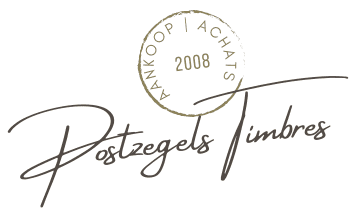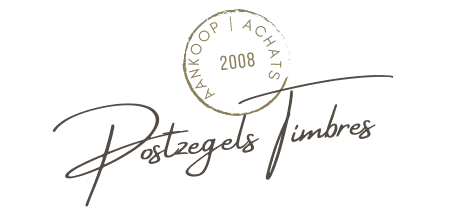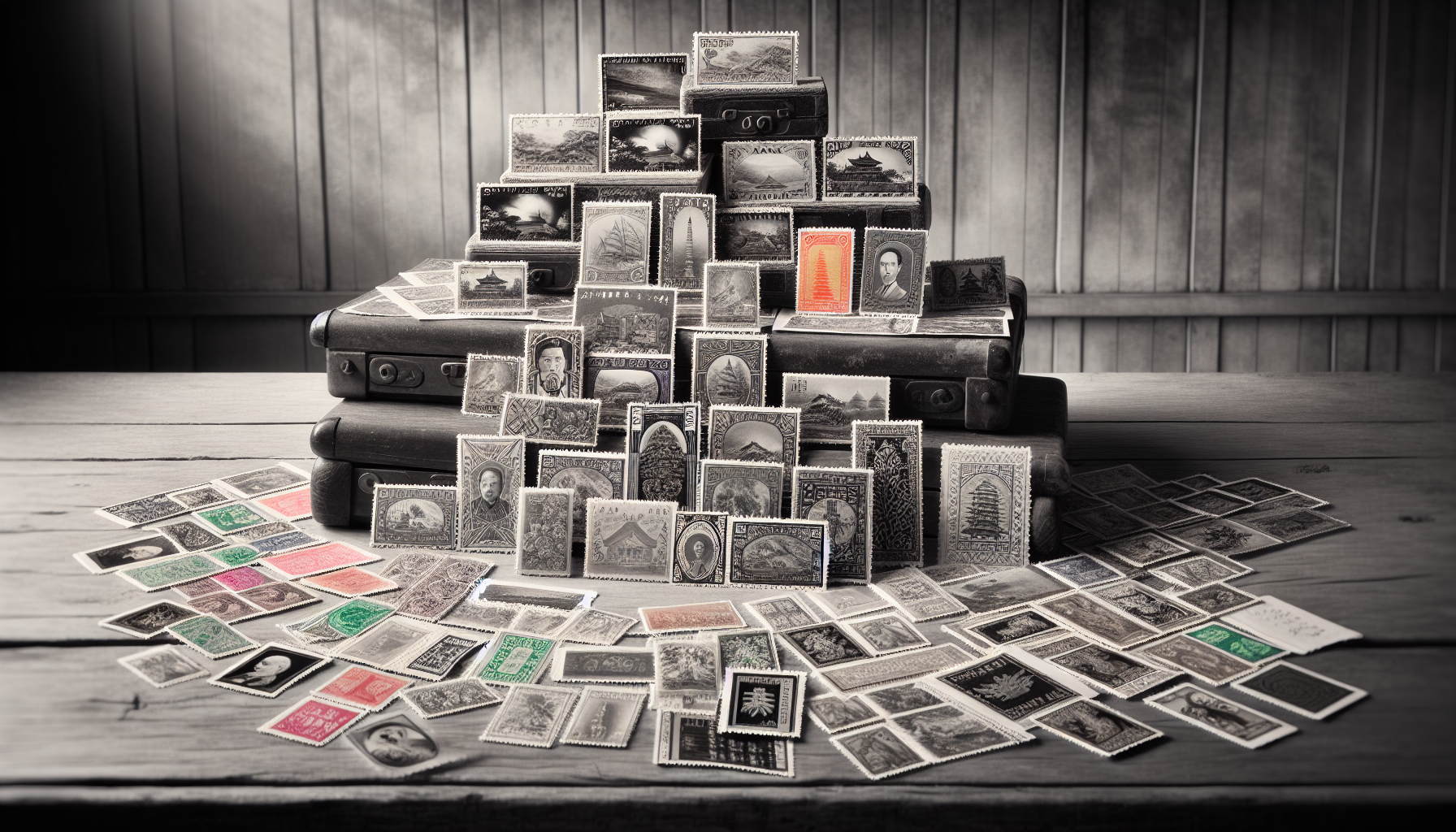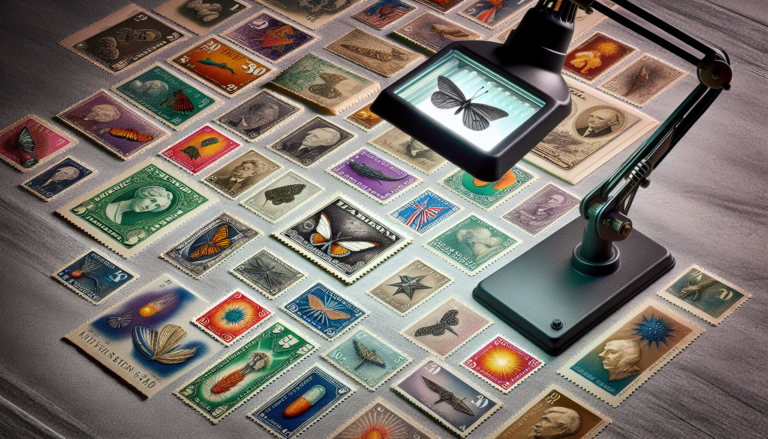Hi ! Do you know how to recognize stamps without mastering the language: Guide to the basics of philately ? Don't worry ; You are not the only one asking yourself this question. It's a bit like solving an enigma, or deciphering a secret code from an old treasure. 🧐 Pascal might say that curiosity is a villainous defect, but with us, passionate about philately , it is an undeniable virtue. Sometimes a simple sliding of the eye on a shape, a color or even a small detail can give you the key to the mystery. It's a bit like playing a treasure hunt with a treasure in the key: collecting stamps . Ready to take up the challenge? Let's go! 🤓
For other tips and fascinating stories on stamps , visit our articles here: Chinese stamp collectors and here .
- A glance at the symbols
- Chrysanthemum branches for Japanese stamps
- Emblem of the imperial chrysant on Burmese stamps issued during the Japanese occupation
- Indra vajra for older Mongolia stamps
- Images of Tuvan shooters for Tannu Tuva stamps
- Solar light icons for a few Chinese stamps
- Textual and alphabetical indices
- Search for francs on the ancient stamps of the Philippines
- Mention of Chulalongkorn for Siam stamps
- Registration of translations in Cyrillic for Mongolia after 1943
- Fen currency to identify manchukuo stamps
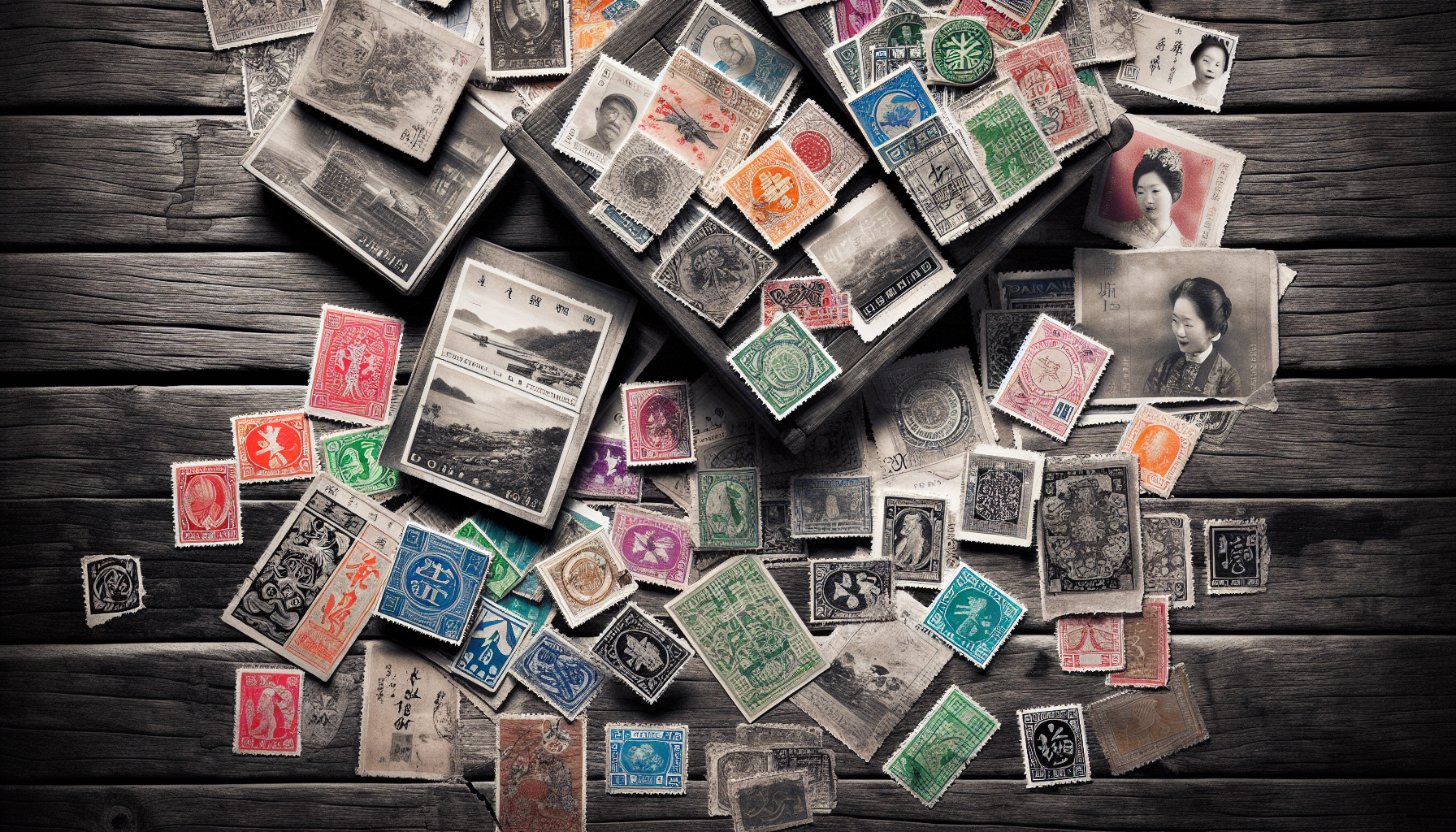
Hey you, the collector's friend, have you already found yourself perplexed in the face of an Asian stamp that you don't understand about the inscriptions? 🧐 Don't panic! Me, Philatelie stamp, I will give you some tips to sail in this ocean of stamps and help you identify these little stressless wonders. And if you need to sell your China stamps , contact Pascal on 0473 444 706, he will love to help you! 😉
Summary
ToggleTips to decipher Asian stamps
To start your philatelic trip to Asia, keep a good old "Linn's Stamp Identifier" near you. Sometimes it can take time, but don't forget, even a marathon ends with a last step. And then, you will see, when you find the origin of this stamp, you will have the impression of having found the treasure at the end of the rainbow. 🌈
The flags are your friends! A flag, even with a million stars, can give a good clue. If you don't have the memory of an elephant to remember the flags, Google, your old internet friend, is there to help you. Simply type "flags of the world" and lets the magic operate. 🏴☠️
Precious symbols and indices
The symbols are more telling than a thousand words; So open the eye. When you come across a Japanese stamp, for example, search for the chrysanthemian flower. Like an imperial signature, it is often present, as is the notion of "Sen", currency. You will quickly be transformed into modern times detective looking for clues. 🕵️♂️
Pascal, who buys your collection on 0473 444 706, will confirm it: an information cascade can sometimes come out of a simple detail. Thus, in Malaysia, the image of a rubber tree can transform your simple piece of paper into a source of wealth. 🌳💰
Decryption of historical mysteries
History plays a key role. Knowing the context often makes it possible to remove the mystery. Have you crossed Siam stamps for example? The young Chulalongkorn, an endearing king of the "king and me", often appears. It's a bit like finding his characters with favorite films, but on stamp! 🎬
Then, if you want to impress your philatelist , mentions Manchukuo; This unusual name for some hides a fascinating history of Manchuria under Japanese influence. And do not forget, where the pagodas flourish, the mystery clears. 🏯
Small shades and subtle details
In the world of philatelie , details can be kings. In Mongolia, for example, the Vajra of Indra can arise on a stamp without warning. Later, you may see inscriptions in a cyrillic alphabet singing the history of the country. 📜
Tannu Tuva is one of those stamps that amuses and intrigues at the same time. What about a triangle -shaped stamp or with a meditation monk? A offbeat trip but oh so rewarding. 🏹
And if you feel overwhelmed, take a cup of tea, think of me, Philatelie stamp, and remember: all large collection begins with a stamp! If you are short of stamps or you try to find out the value of these, do not hesitate to consult Pascal on 0473 444 706. 🍵
Why do not savor this journey through time and space, noting the brand that each nation has left on these miniature rectangles? To find the soul of each stamp is a bit like reading the great classics of literature: complex but always satisfactory. 📚
And if you want to know more, do not hesitate to visit these useful links: impact of Chinese stamps , how to well identify your stamps , and estimate of Asian art stamps . Have a good trip through this captivating world! 🌍✉️
Basic guide to philately to recognize Asian stamps 🌏📬
| Key element 🔑 | Recognition index 📌 |
|---|---|
| Flags 🌟 | Look for distinctive symbols like the single star. |
| Traditional symbols 🏯 | Identify the image of the chrysanthemum for Japan. |
| Non Latin writing ✍️ | Consult the guides on the Greek or Cyrillic alphabets. |
| Images of characters ⛩️ | Find the effigies of monarchs such as Chulalongkorn for Siam. |
| Religious symbols 🙏 | Identify the Vajra of Indra for Mongolia. |
| Japanese occupation 🇯🇵 | Search for specific overloads or patterns such as the Manchukuo pagoda. |
| Imperial crestes 💮 | Identify the imperial ridges on the old shows. |
| Overloads and surcharges 💵 | Use specialized books for China. |
| Language indications 🈺 | Observe familiar characters on modern China stamps. |
| Unusual forms 🔺 | Focus on triangular forms for Tannu Tuva. |
Philately: a borderless trip 🚀
Hi, young adventurer! 🕵️♂️ Traveling around the world of Asian stamps is a bit like embarking on a treasure hunt beyond linguistic terms. Sometimes you don't understand the text, but don't worry! You don't need to know how to read Thai or Japanese to enjoy a magnificent stamp.
Imagine that you are looking for a hidden treasure. Each stamp is a mysterious island to discover. How to recognize Asian stamps? Observe well; The patterns, the colors, and even the small inscriptions that will give you clues on how to recognize Asian stamps. Think of each stamp as at the start of an investigation. Pascal would say that "curiosity is natural to men"; And it's your best asset here.
By immersing yourself in this universe, remember that you have a magic wand: Internet. Simply type "flags of the world" and let yourself be guided by intuition. Yes, yes ... it's the same star flag that you had seen in your notes. It's in Korea, isn't it? 🎌
And what about symbols? 🤔 Here is a secret: the chrysanthemums of the Japanese dynasty or the dazzling sun of China are some of the clues to identify these philatelic gems. Play Sherlock!
Finally, even if your collection is still embryonic, do not forget that it is by forging that we become a blacksmith. Pascal would smile at the idea that you have a lot of fun by resolving a mystery. It is never too late to explore new territories, a stamp at a time!
Your passion for philately will lead you to explore how to recognize Asian stamps with an ever more sharp eye.
So, are you ready to deploy your philatelist wings and explore all these colorful worlds? Do not forget your guide: how to recognize Asian stamps without mastering the language, an endless adventure where each new discovery brings this spark of joy; 😉🌏
Base guide of philately: recognize Asian stamps without controlling the language
🧐 How to recognize a nameless stamp of visible countries? Uses a stamp identification book. For example, Linn's Stamp Identifier can be a useful tool, even if sometimes it takes time to identify the country of origin.
🔠 What to do if the stamp inscriptions are in an unknown alphabet? Consult the section on alphabets in your identification book. Compare the characters with those of the Greek or cyrillic alphabets to find correspondence.
🌐 Are the visual clues reliable? Yes, some symbols can help identify the origin. For example, the chrysanthemum on the first stamps of Japan or the Vajra d'Arra on the first stamps of Mongolia.
To help you sail in this universe, it is essential to understand how to recognize Asian stamps without knowing local languages. It will make your experience even more enriching.
🗺️ How to identify the stamps of North Korea? Looking for clues like the unique star flag. Once identified, consults the Scott Standard Postage Stamp to confirm.
🇯🇵 What should I know about Japanese occupation stamps? These can be difficult to identify and were often overloaded to be used in occupied countries, such as Burma or Malaysia.
🇨🇳 Are there specific clues for China's stamps? Yes, many of their ancient stamps carry the word "china" or a bright sun pattern, which can help their identification.
This quest to learn how to recognize Asian stamps is a real journey within the culture and history of each country.
🎨 How were Tannu Tuva's stamps? They often had unusual forms and fantastic illustrations. The first stamps presented images such as the wheel of Buddhist truth .
In summary, to collect these little wonders, it is fundamental to know how to recognize Asian stamps from the start.
👑 What should I find on the stamps of the Philippines under Spanish domination? The first stamps wore the image of Queen Isabelle II , often without visible country name, and included the inscription "Franco" to indicate the paid port.
🎭 Who is Chulalongkorn on Siam's stamps? Known as the young king in "The King and I", his image appears on many stamps in Siam (now Thailand) to help you recognize them.
Philatelic decryption: recognize Asian stamps
| Indicator | Recognition tip |
|---|---|
| Absence of name | Use specific patterns such as flags or emblems. |
| Symbolism | Chrysanthemum for Japan, Vajra for Mongolia. |
| Historical figures | King Chulalongkorn indicates Siam. |
| Overloads and seals | Often reveal an occupation or a change of sovereignty. |
| Local name | A non -Latin alphabet name is crucial. |
| National emblems | Sun for China, star for North Korea. |
| Raw impressions | May indicate a period of disorders or occupation. |
| Unusual geometry | Unique triangle or polygons shapes signal Tannu Tuva. |
| Monetary unit | Fen or sen can direct you to the history of the stamp. |
| Cultural staging | Traditional costumes or agricultural scenes often indicate origin. |
How to decipher Asian stamps: essential for the curious philatelist
The recognition of Asian stamps without in -depth knowledge of regional languages can be delicate, but with a little practice and a methodical approach, it gradually becomes more accessible. Stamp collectors often have to play detectives and use visual clues to identify the origin of stamps.
Take the time to learn how to recognize Asian stamps, because this skill will be beneficial in the long term.
One of the first clues to seek is the use of distinctive symbols . Japanese stamp chrysantme is an imperial symbol and appears frequently. On the ancient stamps of Japan, we can see it attached to the images of local fauna, such as a mandarin duck. Another clue lies in the mention of the motto "SN" , which means "SEN", that is a Japanese monetary unit.
Flags also serve as useful clues. However, it is important to note that many countries have flags with similar patterns, such as a five -pointed star. When a flag is not enough, collectors can turn their research to specialized collections, which are gold mines of information.
In the case of Burma under Japanese occupation, stamps show the Japanese chrysantme and have texts in Cyrillic and Burmese characters. Another fascinating example is the stamp showing a Burmese girl carrying a water pot, illustrating the cultural collaboration of these troubled eras.
Remember that knowing how to recognize Asian stamps will enrich your collection not only, but also your exchanges with other collectors.
Manchukuo stamps , an old Japanese version of Manchuria, the mention of the motto "Fen", a subdivision of the Japanese currency, is precious. The name "Manchu State Postal Administration" is also a good indicator for these stamps.
In the same way, the importance of certain cultural objects, such as Vajra d'Arra on the first timbres of Mongolia , offers crucial tracks. This symbol represents a significant Buddhist artifact, emphasizing the rich spiritual tradition of the region.
The stamps of Tannu Tuva are unique not only by their forms (triangular, polygons) but also by the illustrations of cultural scenes like that of the Tuvans archers. Although this entity no longer exists as a sovereign state, these stamps tell fascinating stories through their images.
When you immerse yourself in the art of philately, do not forget to always keep in mind how to recognize Asian stamps to enrich your collection.
The first programs of stamps from the Philippines bear the image of Queen Isabella II, creating a certain ambiguity with Spanish stamps. The word "Franco" appears there, designating the postal service, while using the motto of the cuartos.
For those who are interested in China , the first stamps are sometimes easier to identify thanks to the clear inscription of the word "China". However, many ancient stamps contain overwhelms and surcharges that are difficult to decipher without specialized documentation.
Finally, the habit and the frequent exposure to different alphabets , symbols and patterns gradually reinforce the capacity of any philatelist to identify Asian stamps. Like all learning, it improves the eye and enriches the mind with beauty and history engraved in paper. Collectors learn to detect subtleties with each new stamp studied, adding a new room to their global philatelic puzzle.
Philately is an exciting art that invites you to discover the fascinating world of Asian stamps , even if you do not master local languages. Imagine that you hold in your hands a postage stamp from an Asian country. To help you in this adventure, immerse yourself in the collections of Belgian stamps , famous for their beauty and diversity-a real delight for any collector! For an enriching experience, uses online tools such as Linn's Stamp Identify or consult the practical guide to recognize Asian stamps .
Do not underestimate the importance of knowing how to recognize Asian stamps, as each detail can reveal precious information on their origin.
Finally, do not forget that understanding how to recognize Asian stamps is a skill that develops over time and experience.
Also, familiarizing yourself with the techniques of how to recognize Asian stamps will allow you to improve your collection.
No matter where you come from, you can learn how to recognize Asian stamps and enjoy each discovery.
The key to this adventure is to master how to recognize Asian stamps, and thus, each stamp will become a piece in the story that you will discover.
